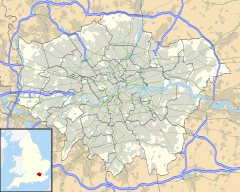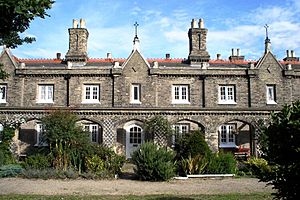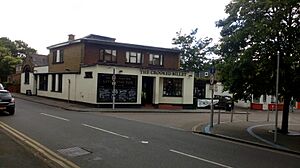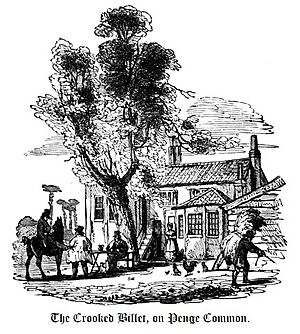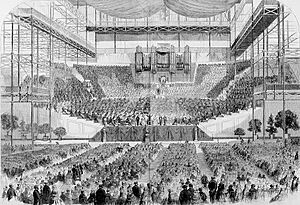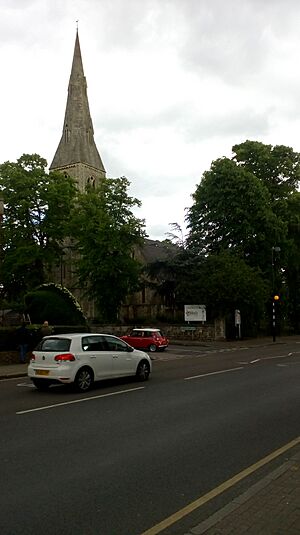Penge facts for kids
Quick facts for kids Penge |
|
|---|---|
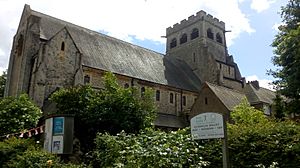 Congregational Church, Penge |
|
| OS grid reference | TQ345705 |
| • Charing Cross | 7.1 mi (11.4 km) NNW |
| London borough | |
| Ceremonial county | Greater London |
| Region | |
| Country | England |
| Sovereign state | United Kingdom |
| Post town | LONDON |
| Postcode district | SE20 |
| Dialling code | 020 |
| Police | Metropolitan |
| Fire | London |
| Ambulance | London |
| EU Parliament | London |
| UK Parliament |
|
| London Assembly |
|
Penge (/pɛndʒ/) is a lively suburb in South East London, England. It is now part of the London Borough of Bromley. Penge is about 3.5 miles west of Bromley, 3.7 miles north east of Croydon, and 7.1 miles south east of Charing Cross.
Contents
Penge's History
Penge was once a small village. It was first mentioned as "Penceat" in an old Anglo-Saxon document from the year 957. In this document, King Eadwig gave Penge Common to a nobleman called Lyfing. Most historians believe the name 'Penge' comes from a Celtic word, Penceat. This word means 'edge of wood'. It describes how the area was once covered in thick forests. A large mine in South Africa was also named Penge. This was because a British director thought the two places looked alike.
Early Days and the Crooked Billet Pub
Penge was a quiet area with very few people living there before trains arrived. Travellers passing through Penge would have seen a large common, which is like a shared grassy area. There was also a small inn, or pub, nearby. This green area was called Pensgreene on a map from 1607.
The Crooked Billet pub is the oldest pub in Penge. Some say it has been there since 1601. It is well-known today because it is a bus route stop. Buses have ended their journeys here for a long time. The pub was damaged during World War Two and then rebuilt.
How Penge Grew
The London and Croydon Canal was built across Penge Common. This is now where the railway line runs through Penge West railway station. After the canal closed, the London and Croydon Railway was built on the same path. It opened in 1839.
Penge became a popular place in the Victorian era. This was because of the railway line and its closeness to the Crystal Palace. People would visit the Crystal Palace during the day. Then they would take a tram down to Penge. Penge was famous for having many pubs and two music halls. These were The King's Hall and the Empire Theatre.
By 1862, maps showed that large homes had been built in Penge. However, Penge also became known for some sad events. In 1877, a wealthy woman named Harriet Staunton and her baby son died from starvation. This was caused by her husband and his friends. A novel called Harriet was written about this case in 1934.
How Penge is Governed
Penge used to be part of the parish of Battersea. The old border between Kent and Surrey counties was its eastern edge. In 1855, Penge was included in the area managed by the Metropolitan Board of Works.
Later, in 1900, Penge became its own area called Penge Urban District. This district was removed from London and added to Kent. In 1965, the urban district was closed. Its area joined other districts to form the London Borough of Bromley. When Penge became an Urban District, Penge New Road was renamed Penge High Street.
The Penge Urban District included Anerley, Penge, and Upper Norwood. It also had most of Crystal Palace Park.
Penge has been part of different parliamentary areas over the years. Since the 2010 general election, it has been part of the Lewisham West and Penge constituency. In 2024, it became part of the new Beckenham and Penge constituency. For local government, Penge is in the Penge and Cator ward. This area had a population of 17,326 people in 2011.
Penge's Location
Nearby Areas
Culture and Community
- Penge is home to many pubs. It was known in Victorian times for having '25 pubs to the square mile'. The Crooked Billet is the oldest.
- The Pawleyne Arms pub is currently the end stop for the 176 bus service.
- Many pubs in Maple Road have changed their names. The Dew Drop Inn became The Market Tavern. The London Tavern became The Hop Exchange and then The Hop House. The Lord Palmerston is now a pizza place. The King William IV became The Crown and is now The Maple Tree.
- Penge also has several clubs. These include a Conservative Club and The Penge & District Trade Union & Labour Social Club.
- A contemporary fine art gallery called Tension opened in Penge in April 2019. It is located at 135 Maple Road.
Community Facilities
Small parts of the original Penge Common still exist in Betts Park. Winsford Gardens used to be part of the grounds of Chesham Park and Winsford House.
Important Landmarks
- Penge has several old almshouses. These are special homes for people who need help. The oldest are the Free Watermen and Lightermen's Almshouses. They were built in 1840–1841 for retired boatmen and their widows. These buildings are now private homes.
- The Queen Adelaide Almshouses were built in 1848. Queen Adelaide of Saxe-Meiningen, the wife of King William IV, paid for them. They were for twelve widows or daughters of naval officers. These are also now private homes.
- St. John's Cottages on Maple Road were built as almshouses in 1863. In 1959, one cottage was destroyed by a gas explosion, but it was rebuilt to look like the original.
- The police station at the corner of the High Street and Green Lane was thought to be London's oldest working police station when it closed in 2010.
- The Crystal Palace Transmitter was built in 1956. It was the tallest structure in the UK for a short time. It remained the tallest structure in London until 1991.
=Images for kids
Getting Around Penge
Train Services
Penge West station has London Overground trains. These go to Dalston Junction, Highbury & Islington, and West Croydon.
Penge East and Kent House stations also serve the area. They have National Rail trains to London Victoria, Bromley South, and Orpington. Sometimes, trains go further to Sevenoaks.
Bus Services
Penge is served by many London Buses routes. These include routes 75, 176, 194, 197, 227, 354, 356, 358, and N3. These buses connect Penge to places like Beckenham, Bromley, Croydon, Crystal Palace, and Sydenham.
Roads
Three main roads pass through Penge. These are the A213, A214, and A234.
Tram Services
Avenue Road is at the southern edge of Penge. It offers tram links to Wimbledon, Beckenham, and Croydon.
Education in Penge
St Johns C.E. Primary School started as part of the Old Penge Chapel in 1837. In the 1850s, the school took over the entire old chapel building. A new school building opened in 1978.
The Beckenham and Penge County Grammar School for boys moved to Penge High Street in 1931. It later moved to Eden Park, Beckenham, in 1969.
Religious Buildings
St John the Evangelist's Church, Penge in Beckenham Road was built in 1850. Penge Congregational Church was built in 1912. It has beautiful stained glass windows by William Morris.
Sports and Recreation
Crystal Palace Park is home to the National Sports Centre. This centre has a top-level athletic stadium. It also has a former motorsport circuit. This circuit was used in the 1969 film The Italian Job.
Crystal Palace Park once had a football ground. It hosted the FA Cup final from 1895 to 1914. Crystal Palace FC played their matches here from their start in 1905 until World War One. Other sports areas in Penge include Alexandra Recreation Ground, Penge Recreation Ground, and Royston Playing Fields.
Famous People from Penge
- Thomas Crapper (1836–1910) was a famous plumber. He lived in Penge and helped develop the U-bend for toilets.
- Walter de la Mare (1873–1956) was a famous poet and writer of ghost stories. He lived in Penge for many years.
- Camille Pissarro (1830–1903), a French impressionist painter, lived in Penge in the 1870s.
- Malcolm Muggeridge (1903–1990) was a British journalist and author.
- Bonar Law (1858–1923) was a Prime Minister. He lived in Oakfield Road in Penge.
- Helena Normanton (1882–1957) was the first woman to work as a barrister in the UK.
- Bill Wyman (born 1936), the bassist for The Rolling Stones, lived in Penge as a child.
- George Daniels (1926–2010) was a famous watchmaker. He invented the Coaxial escapement used by Omega watches. He lived in Thornsett Road.
- Dadabhai Naoroji was an important Indian independence campaigner and a MP. He lived in Anerley Park from 1897 to 1904/5.


